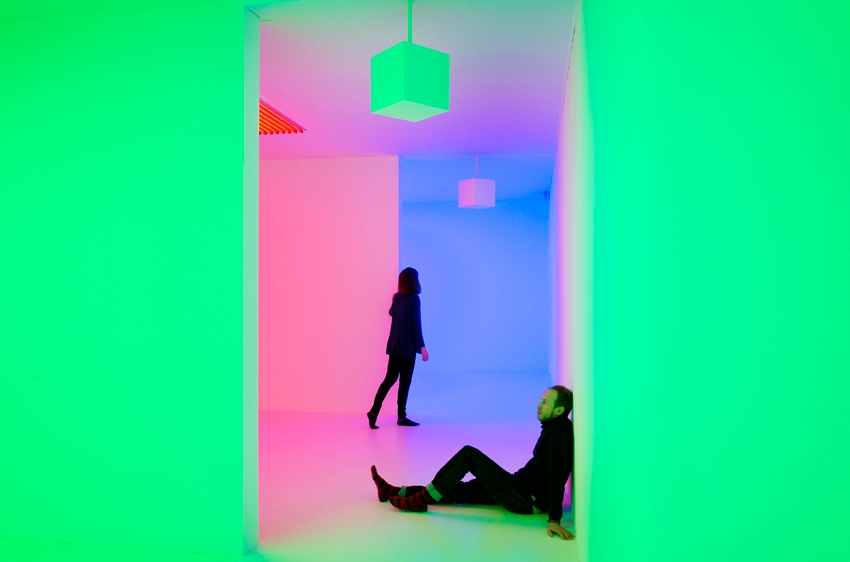There’s a poster on the platform at Barbican underground station, my stop now when I head to ArtReview’s fancy new offices. The poster is for the Hayward Gallery’s current exhibition, Light Show, with an upbeat, punning quote from The Independent newspaper: ‘Hayward Gallery trips the light switch fantastic!’ On the show’s website, a YouTube clip previews the show’s glowing array of artworks that use artificial light, and a warning banner declares that ‘Light Show is extremely popular and tickets are selling out daily. You should expect to queue upon arrival and advance booking is strongly recommended.’
Light Show comes hard on the heels of Rain Room, by digital art/design outfit Random International, at the Barbican’s Curve Gallery – an installation of digitally controlled rain that, with some slick motion-sensor technology, allows visitors to walk through a downpour without getting wet. The show attracted 77,000 people and extended its opening hours on the last weekend to cope with what were often eight-hour queues.
It’s one of those strange phenomena of austerity Britain that in London the big venues are attracting ever bigger crowds. Tate Modern recently announced that it had 5.3 million visitors in 2012, the highest annual attendance in its history, up 9.5 percent on the previous year. Sure, you can count the Damien Hirst show and that Olympics stuff, and the bad weather that meant people didn’t got to outdoor attractions, apparently, but even the venerable Tate Britain managed a 4.3 percent uptick on 2011, so go figure.
Regardless of one-off occurrences and the British weather, it’s still the case that the style of exhibitionmaking in public institutions is changing. Aside from the familiar pumped-up blockbuster shows (from the Hirst retrospective to the Manet portrait show at the Royal Academy), the most striking development is the turn to a more overt ‘experience art’. One major aspect of this is the relentless rise of performance art as the darling of public gallery curators, a development now fully institutionalised in London with the inauguration of Tate Modern’s Tanks spaces, with their commitment to live, performance and moving-image art, and the roaring success of last year’s Tino Sehgal Turbine Hall commission.
But ‘experience art’ goes further than the belated recognition of performance art; immersive, sensory, interactive installations and exhibitions like Light Show or Rain Room point to a shift in the curatorial agenda of public art galleries. It’s not just driven by the need to get bums on seats or feet through the door in hard times. (Although that doesn’t hurt: while curators and artists huffily insist that this performance-art business is very expensive to stage, it remains the case that experiential and time-based events have become a growth area for ticketed programming at big art venues.) Rather, what this shift signals, more than anything, is the reinvention of the public gallery as a venue for a new, less specialist and more distracted public; as one person queuing for Rain Room told the London Evening Standard, ‘I waited at H&M when Jimmy Choo was launching a new line, so I thought I’d give it a go for a more cultural cause.’
The problem isn’t with the public or the curators necessarily – after all, why wouldn’t you want to bring all types of artwork to people’s attention? The problem is that big public institutions are becoming increasingly proactive in driving a cultural market for art that reflects their predicament as big public institutions – namely, that they should justify their existence by pointing to the fact that the public ‘likes’ what they do enough to turn up in big numbers.
Underlying this is an anxiety among art institutions that, actually, the public might not really ‘get’ what goes on ‘out there’, in the ‘real’ artworld of commercial galleries, art fairs and small nonprofit operations. So in failing to make sense of what’s going on ‘out there’ for their public, big public venues are turning themselves into the main attraction. Of course, it might truly be that event-performance-experience art is where art is headed. Yet if so, there’s still a major question of power at stake. When large institutions monopolise culture at the expense of small initiatives and informal economies, and when their cultural agenda is defined more by their interests than those of the culture they were supposed to be representing, art runs the risk of becoming more hierarchical and more homogenous, less polyphonic, less risky – and less free.
This article was first published in the April 2013 issue
